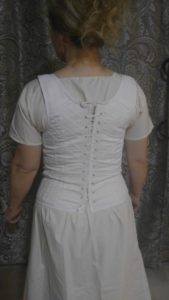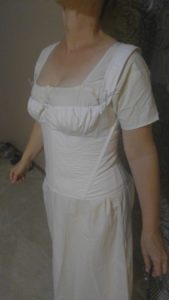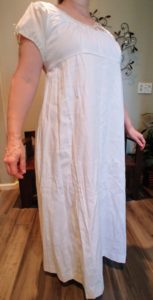 If you’ve been following all my scandalous (gasp!) posts about all the underpinnings a Regency lady wore, but wished for a quick overall in one place, this post is for you.
If you’ve been following all my scandalous (gasp!) posts about all the underpinnings a Regency lady wore, but wished for a quick overall in one place, this post is for you.
The first layer is the shift or chemise. Notice how plain and unadorned it is as well as being very shapeless. A chemise/shift provided a barrier between a woman’s body and the other layers of clothing, so the shift absorbed perspiration. I had my shift made out of poly cotton batiste which is as close to an heirloom fabric as I could find. A fine weave muslin would have worked well, too.
 The next layer is the corset, which, during the Regency, was called Stays. This style of stays is called long stays. This is the kind of stays nearly every women, rich or poor, wore. The material we used these for stays was cotton twill. Later, I discovered that another good choice for stays or corsets is Coutil (or Coutille), a woven cloth created specifically for making corsets. These grommets are metal, but Regency stays have stitched button holes. Some women preferred short stays during the summer or if they were especially small busted, or if they didn’t have someone to help lace up their
The next layer is the corset, which, during the Regency, was called Stays. This style of stays is called long stays. This is the kind of stays nearly every women, rich or poor, wore. The material we used these for stays was cotton twill. Later, I discovered that another good choice for stays or corsets is Coutil (or Coutille), a woven cloth created specifically for making corsets. These grommets are metal, but Regency stays have stitched button holes. Some women preferred short stays during the summer or if they were especially small busted, or if they didn’t have someone to help lace up their

stays—although that would have been very rare—but these provided less support and lacked the smoothing effects of the long stays so they were not anywhere near as popular. It is believed that more of the working classes wore short stays than members of the upper classes but most working women wore long stays, too. The center has a wooden busk which is designed to help the garment lay flat, as well as help lift and separate the breasts. It loosely resembles a ruler, and in some stays it can be removed for washing.
 The next layer is the petticoat. Regency Ladies wore one petticoat underneath her formal gowns. The petticoat resembles a sleeveless jumper with a scooped neckline. The petticoat helps create a smooth canvas over which ladies wore the transparent muslins and silks of the era that were intended to flow elegantly around a lady’s form. To make this petticoat, we choose cotton sateen, made with spun yarn instead of filament. Sateen is similar to muslin so it still feels authentic and has a really nice feel to it, a nice shimmer, and it drapes beautifully. The petticoat ties shut at the back. It is anchored at the back with hooks and eyelets. This pattern our lovely model is wearing is smooth at the front and sides, and pleated at the back to keep the streamlined silhouette while still allowing room for leg movement. Petticoats were often embellished at the hem with tucks or embroidery. In very cold weather our Regency lady probably worn more petticoats for warmth, but her gowns would have to be made large enough to accommodate that, unless she is wearing an apron-style gown that is less fitted.
The next layer is the petticoat. Regency Ladies wore one petticoat underneath her formal gowns. The petticoat resembles a sleeveless jumper with a scooped neckline. The petticoat helps create a smooth canvas over which ladies wore the transparent muslins and silks of the era that were intended to flow elegantly around a lady’s form. To make this petticoat, we choose cotton sateen, made with spun yarn instead of filament. Sateen is similar to muslin so it still feels authentic and has a really nice feel to it, a nice shimmer, and it drapes beautifully. The petticoat ties shut at the back. It is anchored at the back with hooks and eyelets. This pattern our lovely model is wearing is smooth at the front and sides, and pleated at the back to keep the streamlined silhouette while still allowing room for leg movement. Petticoats were often embellished at the hem with tucks or embroidery. In very cold weather our Regency lady probably worn more petticoats for warmth, but her gowns would have to be made large enough to accommodate that, unless she is wearing an apron-style gown that is less fitted.
At this point, the lady might have donned her gown, or her stockings. I’ll address gowns in another post, so I’ll dress my lady in stockings, next.
 Stockings fastened with garters that tied, buckled, or hooked either at the thigh or just above the knee. Stripes on any and all garments were extremely popular in the 1790s but by the Regency, plainer styles, almost always white, either plain or stitched with white or colored embroidery became popular. I don’t have any authentic Regency stockings (yet) but our Regency lady would have worn knit stockings of cotton or silk (or wool if it was cold. People often wore thicker stockings under the fine silk ones for additional warmth if it was a formal setting where silk would be more fashionable. Wearing white cotton underneath their silk also helped hide their leg hair.
Stockings fastened with garters that tied, buckled, or hooked either at the thigh or just above the knee. Stripes on any and all garments were extremely popular in the 1790s but by the Regency, plainer styles, almost always white, either plain or stitched with white or colored embroidery became popular. I don’t have any authentic Regency stockings (yet) but our Regency lady would have worn knit stockings of cotton or silk (or wool if it was cold. People often wore thicker stockings under the fine silk ones for additional warmth if it was a formal setting where silk would be more fashionable. Wearing white cotton underneath their silk also helped hide their leg hair.
It is my hope that the next time you read (or write) a Regency novel, you will better be able to visualize all the undergarments and how they work together to create the desired Regency clothing silhouette that fine ladies prized.
Dressing the Regency Lady posted first on http://donnahatchnovels.tumblr.com/
No comments:
Post a Comment